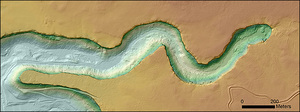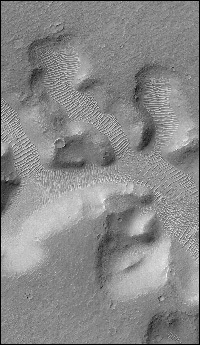There is abundant evidence for Mars being warm and wet in the past but today it appears relatively dry, with water ice confined to the planet's polar caps.
Now new evidence of Martian floods in the distant past has come from a study of a canyon in Idaho, America, that from space looks like a blue snake.
Idaho's Box Canyon is similar to canyons on Mars and may shake up our view of how water shaped the landscape on the Red Planet, reports a study in the journal Science.

|
| ©ASU |
| High-resolution topographic map of Box Canyon, Idaho. Image courtesy of Michael P. Lamb |
Geologists had thought the terrestrial Box Canyon was formed through gradual erosion, as groundwater seeped through the canyon walls and wore the rock away. They also figured this was true for other similarly shaped canyons - which includes many of the canyons on Mars.
All these canyons are "amphitheater-headed", which means they are stubby, ending at a round, steep wall.
Prof Michael Lamb and his colleagues at the University of California, Berkeley took a close look at Box Canyon, focusing on large boulders scattered about and several depressions, or "plunge pools," that appear to have been the site of ancient waterfalls.
They conclude that Box Canyon was scoured out by a massive flood about 45,000 years ago, when ice sheets to the north melted to release massive quantities of water to blast through the canyon.
"Our minimum estimates are 800 to 2800 cubic metres per second. This flood would have has a flow velocity of about 10 meters per second in the canyon," he says.
By extension, it's also possible that these megafloods occurred on Mars.

|
| ©ASU |
| The classic example of this type of valley on Mars is Nirgal Vallis |
A "Yellowstone Park" on Mars has been discovered where hot springs and geysers may once have burst out of the planet's interior, says a second report in Science.
The site is another promising location to search for evidence of present or past life, scientists at the American space agency Nasa believe.
One of Nasa's two Mars Exploration Rovers that landed in January 2004 accidentally stumbled on the find after a wheel jammed.
Deposits of nearly pure silica, which requires a lot of water to form, were revealed by the Spirit rover in Gusev Crater and are thought to have been laid down when volcanic steam or hot water (or maybe both) percolated through the ground, says a team led by Steven Squyres of Cornell University.
"On Earth, hydrothermal deposits teem with life and the associated silica deposits typically contain fossil remains of microbes," says coauthor Prof Jack Farmer, Arizona State University.
"But we don't know if that's the case here," Prof Farmer notes, "because the rovers don't carry instruments that can detect microscopic life."
He adds, "What we can say is that this was once a habitable environment where liquid water and the energy needed for life were present."
High-resolution photos, plus captions and credits, are available here.



Reader Comments
to our Newsletter